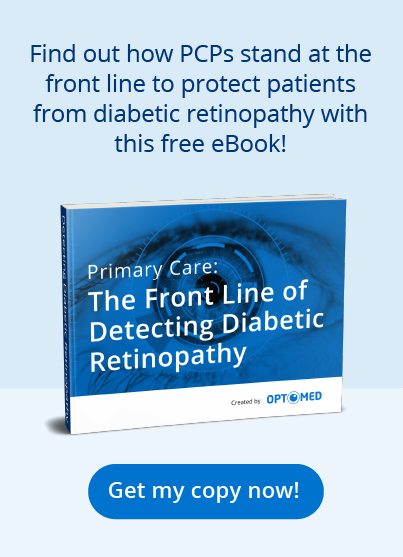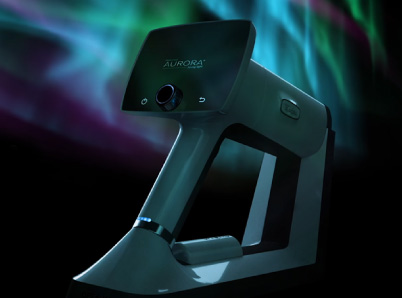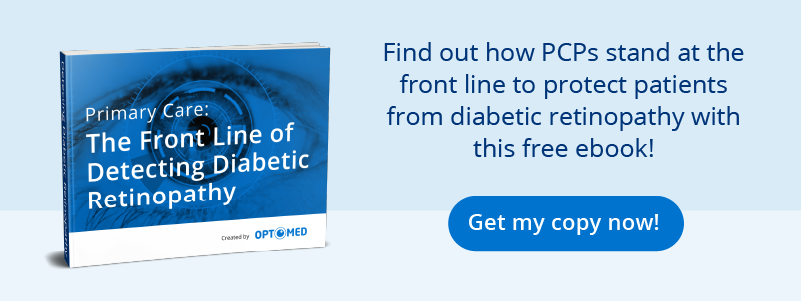Positioning Primary Care Physicians as the First Line of Defense against Diabetic Retinopathy and Facilitating the Primary Care to Specialist Referral Process
Incidence of Diabetes
We are seeing increasing rates of diabetes with each passing year. In 2019, the global prevalence was estimated to be 9.3%. This is predicted to increase to 10.2 % in 2030 and 10.9% by 2045. It’s estimated that approximately 50% of those with diabetes are undiagnosed. One of the unfortunate complications of diabetes is retinopathy. In the United States, approximately 4.4% of people 40 years of age and older have diabetic retinopathy. It is the leading cause of new blindness among working-age American adults. In the US, its economic burden is $493 million per year.
Health Disparities in Diabetes
As is true of most chronic health conditions, there are definite disparities when it comes to diabetes. We see higher rates in minority populations, such as Native Americans and Alaska Natives. The prevalence is also increased in those with lower levels of education. Not only are there disparities in the number of people with diabetes, but the outcomes in these individuals tend to be poorer as well. Racial and ethnic minorities have higher rates of complications from diabetes. One such complication is diabetic retinopathy. In a study examining a population of Mexican Americans, those of lower socioeconomic status had more severe diabetic retinopathy than their higher socioeconomic-status counterparts.
Addressing Health Disparities in Diabetes
To address these disparities, the populations that are most at risk must be reached. When patients are seen regularly by their primary care physician, their diabetes can be properly managed and aid the primary care to specialist referral process. Part of proper diabetes management includes screening for diabetic retinopathy, hence the need to have such important screenings be available at primary care physicians’ offices, whom patients are more likely to visit than an ophthalmologist. The American Academy of Ophthalmology, American Optometric Association, and American Diabetes Association all recommend annual dilated eye exams for those with diabetes. Of those with self-reported diabetes, only about 63.3% follow this recommendation. There are many barriers that prevent people from seeing an eye care professional, such as transportation issues, insurance problems, and finances. Some people are overwhelmed with their multiple health conditions and all the health care professionals they have to see. Limited health literacy is an issue as well, as patients struggle to understand all the guidelines surrounding diabetes management. They may also develop anxiety about potential complications, leading to avoidance. The primary care to specialist referral process can be cumbersome as well. With COVID-19, this problem is compounded, as patients want to avoid unnecessary exposure. That’s where Optomed Aurora comes in.
Non-mydriatic Screening Tool for Diabetic Retinopathy
Optomed Aurora is a portable handheld retinal camera that can be used in a primary care doctor’s office to screen for diabetic retinopathy. It’s quick and easy, so it can be delegated to staff. It doesn’t require pupil dilation, which means patients can drive themselves home. The images can easily be read via telemedicine. This streamlines the primary care to specialist referral process, by only sending those patients who really need to be seen.
Studies for Diabetic Retinopathy Screening
In a study using a non-mydriatic camera for diabetic retinopathy screening, one in five diabetics was found to have retinopathy. Participants were eighteen or older, with type 1 or type 2 diabetes. Most of the retinopathy was found at an early stage, where there is the most potential for intervention. There were also other conditions found incidentally in almost half of the participants, so there are fringe benefits to this type of screening. Cataracts, glaucoma, and macular degeneration can be identified early and managed appropriately.
Diabetic retinopathy screening with a non-mydriatic camera has been shown to be equivalent to the use of dilated fundus photography. This intervention has been shown to be cost-effective and efficient. Patients express satisfaction with the avoidance of dilation and the simplicity of the process.
Optomed Aurora to Screen for Diabetic Retinopathy
Use of Optomed Aurora with telemedicine interpretation increases access to diabetic retinopathy screening, especially where travel distance and access to transportation are issues. When patients see their primary care provider, they can be screened for diabetic retinopathy right then and there, avoiding a separate trip to an optometrist or ophthalmologist. Of course, some patients may still require care by an eye care professional, but these people can be specifically identified. This improves efficiency in the primary care to specialist referral process. In the era of COVID-19, patients can save themselves another trip to the doctor if it’s not absolutely necessary.
Staff can be effortlessly trained on the use of the camera, so the time between doctor and patient is preserved. Once images are read via telemedicine, results can quickly be reported back to the patient. Staff can relay these results, offering reassurance or coordinating referral to an optometrist or ophthalmologist as appropriate.
Optomed Aurora is a cost-effective tool that allows primary care physicians the ability to offer more comprehensive care, ultimately improving health outcomes and patient satisfaction.
Here at Optomed, our mission is to help save the vision of millions of people. By integrating our software and artificial intelligence solutions with our camera, we enable eye screening for everyone, wherever they are. To see how we can equip you to save the sight of more patients, schedule a free consultation today!



